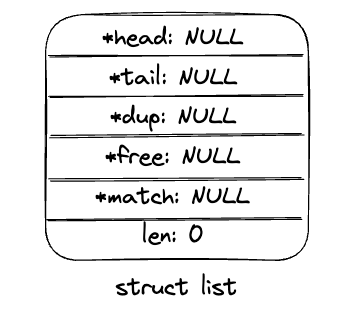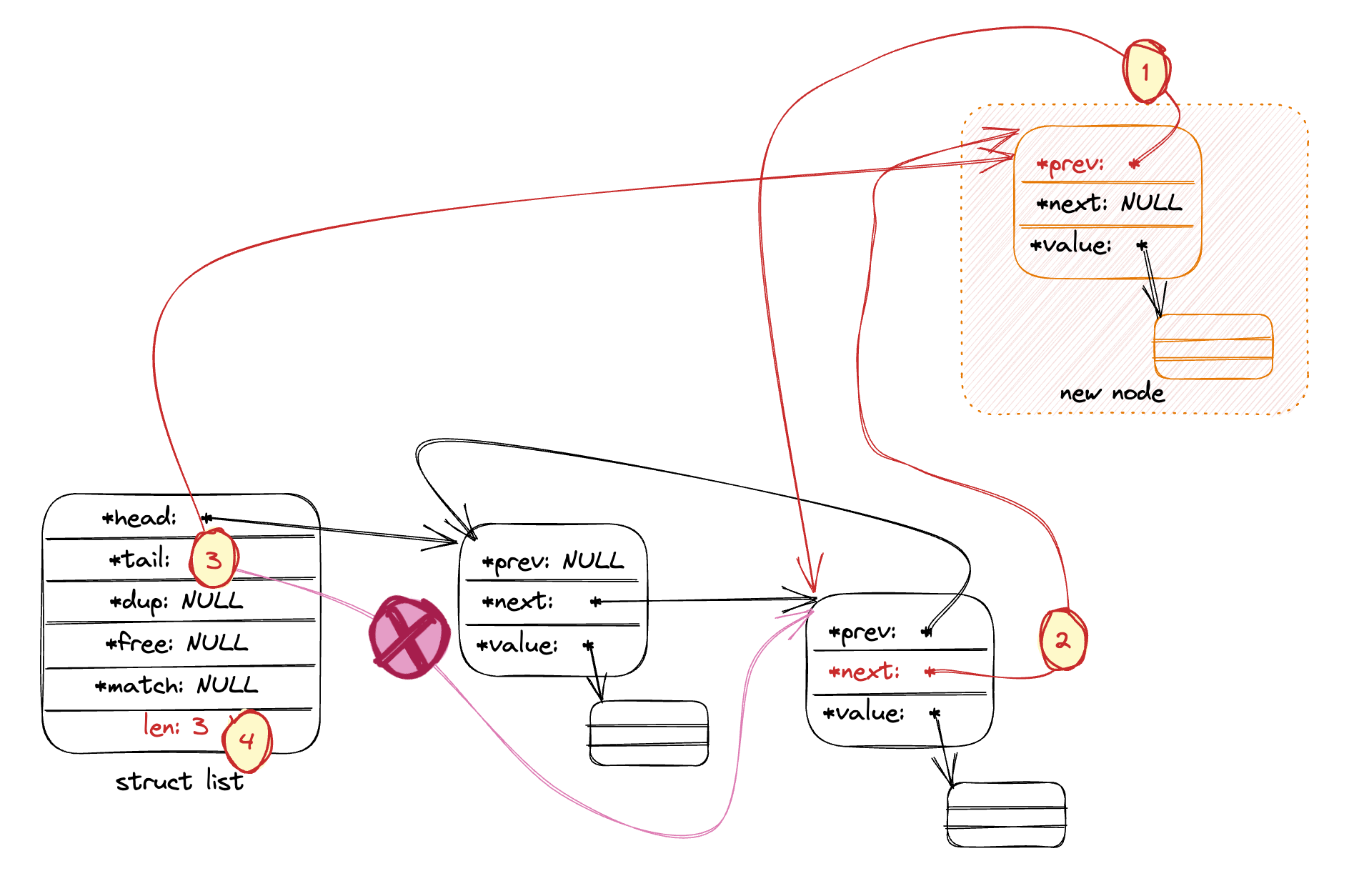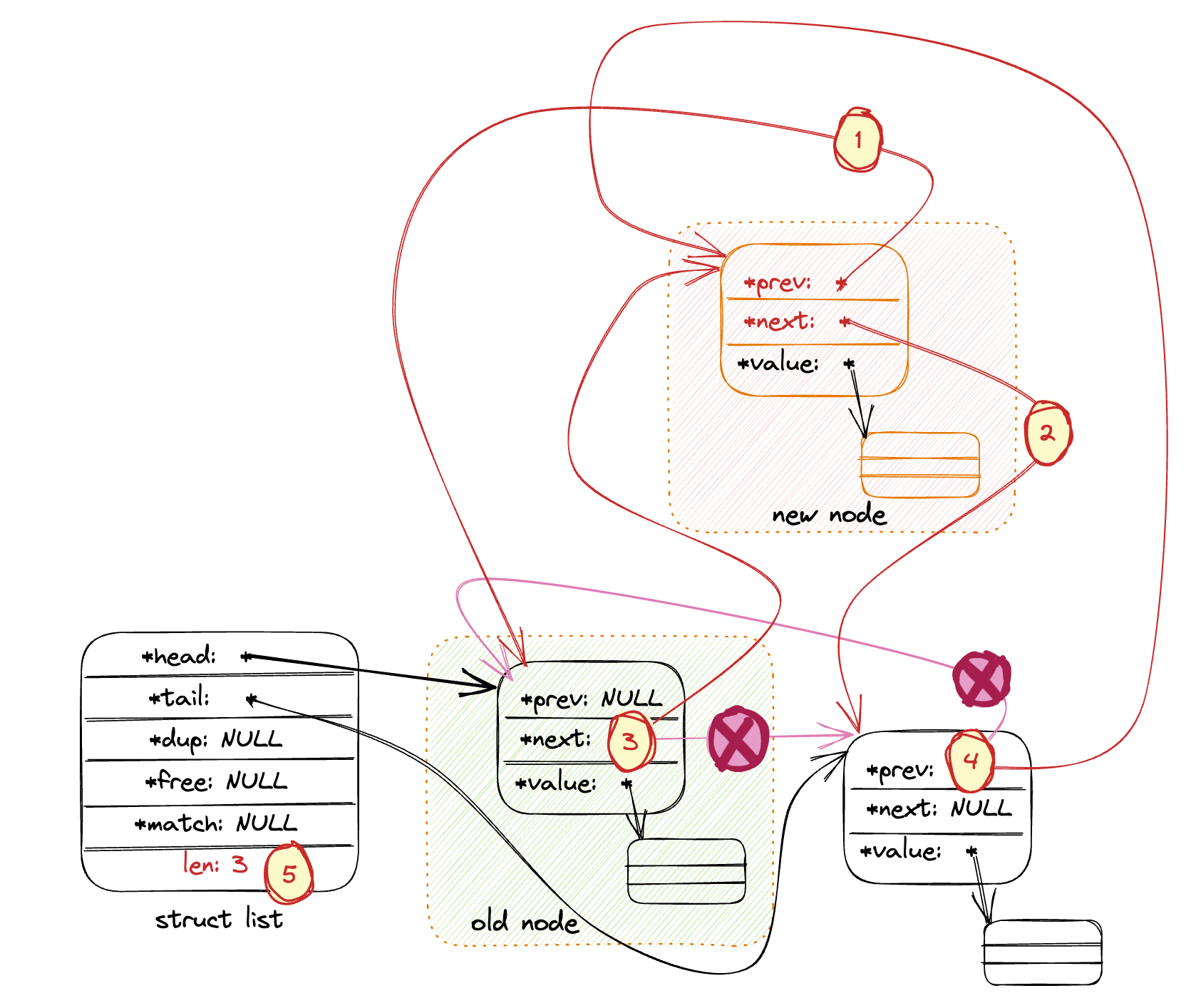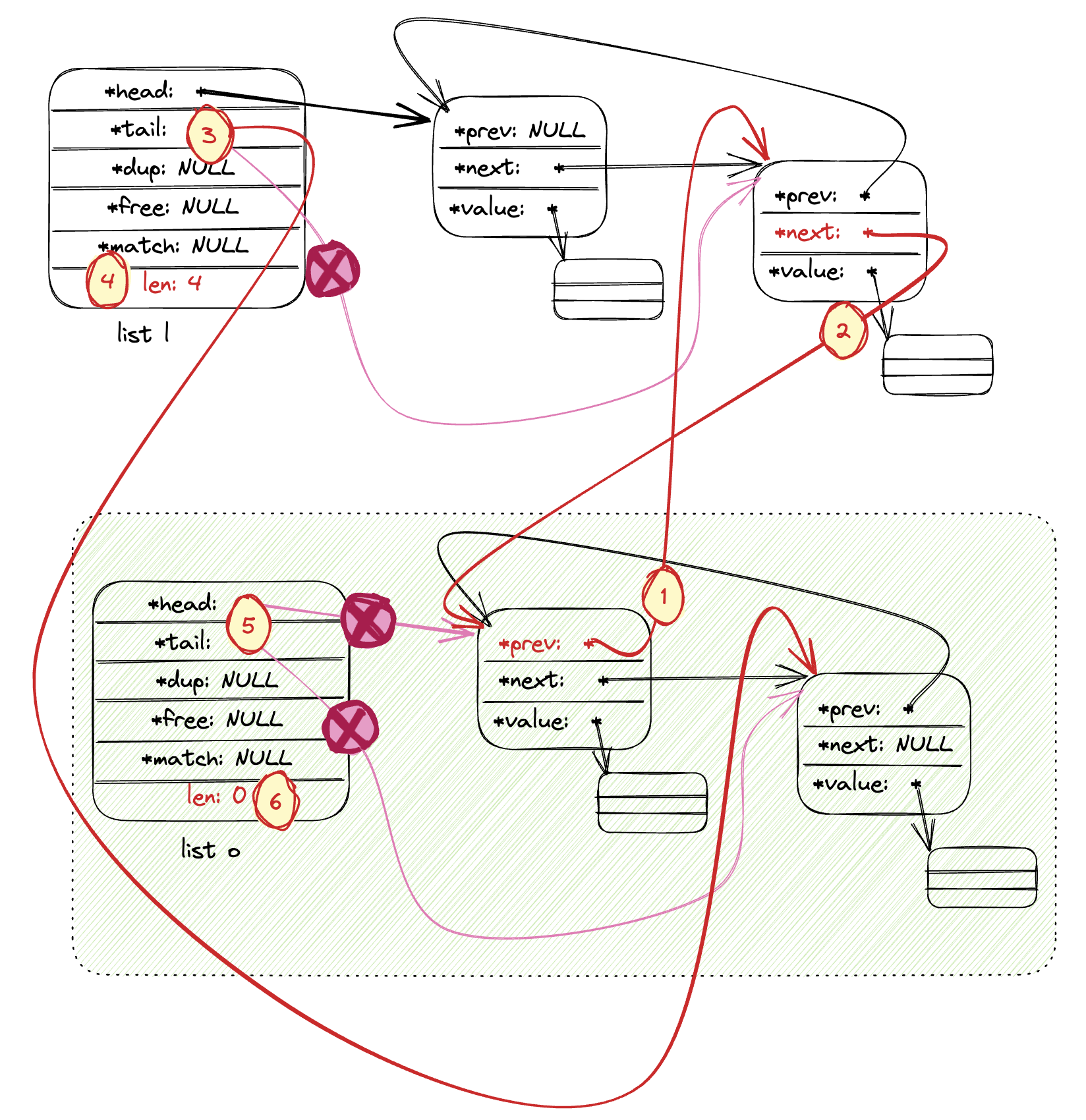- Java锁的逻辑(结合对象头和ObjectMonitor)
- 还在用饼状图?来瞧瞧这些炫酷的百分比可视化新图形(附代码实现)⛵
- 自动注册实体类到EntityFrameworkCore上下文,并适配ABP及ABPVNext
- 基于Sklearn机器学习代码实战
Redis源码中广泛使用 adlist(A generic doubly linked list) ,作为一种通用的双向链表,用于简单的数据集合操作。adlist提供了基本的增删改查能力,并支持用户自定义深拷贝、释放和匹配操作来维护数据集合中的泛化数据 value .
listNode , 作为双向链表, prev , next 指针分别指向前序和后序节点。 void* 指针类型的 value 用于存放泛化的数据类型(如果数据类型的 size 小于 sizeof(void*) , 则可直接存放在 value 中。 否则 value 存放指向该泛化类型的指针)。
// in adlist.h
typedef struct listNode {
struct listNode *prev;
struct listNode *next;
void *value;
} listNode;
listIter , 其中 next 指针指向下一次访问的链表节点。 direction 标识当前迭代器的方向是 AL_START_HEAD(从头到尾遍历) 还是 AL_START_TAIL(从尾到头遍历) 。
// in adlist.h
typedef struct listIter {
listNode *next;
int direction;
} listIter;
/* Directions for iterators */
#define AL_START_HEAD 0
#define AL_START_TAIL 1
list 。 其中, head 和 tail 指针分别指向链表的首节点和尾节点。 len 记录当前链表的长度。函数指针 dup , free 和 match 分别代表业务注册的对泛化类型 value 进行深拷贝,释放和匹配操作的函数。(如果没有注册 dup , 则默认进行浅拷贝。 如果没有注册 free , 则不对 value 进行释放。如果没有注册 match 则直接比较 value 的字面值)
// in adlist.h
typedef struct list {
listNode *head;
listNode *tail;
void *(*dup)(void *ptr);
void (*free)(void *ptr);
int (*match)(void *ptr, void *key);
unsigned long len;
} list;
listCreate 初始化相关字段为零值。可以通过 listSetDupMethod, listSetFreeMethod , listSetMatchMethod 来注册该链表泛化类型 value 的 dup , free 和 match 函数。
/* Create a new list. The created list can be freed with
* listRelease(), but private value of every node need to be freed
* by the user before to call listRelease(), or by setting a free method using
* listSetFreeMethod.
*
* On error, NULL is returned. Otherwise the pointer to the new list. */
list *listCreate(void)
{
struct list *list;
if ((list = zmalloc(sizeof(*list))) == NULL)
return NULL;
list->head = list->tail = NULL;
list->len = 0;
list->dup = NULL;
list->free = NULL;
list->match = NULL;
return list;
}
#define listSetDupMethod(l,m) ((l)->dup = (m))
#define listSetFreeMethod(l,m) ((l)->free = (m))
#define listSetMatchMethod(l,m) ((l)->match = (m))

listAddNodeHead 在空链表插入新节点: 为 value 创建新节点,并让 list 的 head 和 tail 都指向新节点.
在非空链表插入新节点: (1) 将新节点的 next 指向当前首节点(当前首节点将成为第二节点, 将会是新节点的后继节点) (2) 将当前节点的 prev 指向新节点, 新节点作为新的首节点将成为原首节点的前驱节点。 (3) 将 head 从原本指向旧的首节点改为指向新节点, 将新节点作为链表首。 (4) 链表总计数加一 。
/* Add a new node to the list, to head, containing the specified 'value'
* pointer as value.
*
* On error, NULL is returned and no operation is performed (i.e. the
* list remains unaltered).
* On success the 'list' pointer you pass to the function is returned. */
list *listAddNodeHead(list *list, void *value)
{
listNode *node;
if ((node = zmalloc(sizeof(*node))) == NULL)
return NULL;
node->value = value;
listLinkNodeHead(list, node);
return list;
}
/*
* Add a node that has already been allocated to the head of list
*/
void listLinkNodeHead(list* list, listNode *node) {
if (list->len == 0) {
list->head = list->tail = node;
node->prev = node->next = NULL;
} else {
node->prev = NULL;
node->next = list->head;
list->head->prev = node;
list->head = node;
}
list->len++;
}
listAddNodeTail listAddNodeHead 实现一致。 prev 指向当前首节点(当前尾节点将成为倒数第二节点, 将会是新节点的前驱节点) next 指向新节点, 新节点作为新的尾节点将成为原尾节点的后继节点。 tail 从原本指向旧的尾节点改为指向新节点, 将新节点作为链表尾。 
/* Add a new node to the list, to tail, containing the specified 'value'
* pointer as value.
*
* On error, NULL is returned and no operation is performed (i.e. the
* list remains unaltered).
* On success the 'list' pointer you pass to the function is returned. */
list *listAddNodeTail(list *list, void *value)
{
listNode *node;
if ((node = zmalloc(sizeof(*node))) == NULL)
return NULL;
node->value = value;
listLinkNodeTail(list, node);
return list;
}
/*
* Add a node that has already been allocated to the tail of list
*/
void listLinkNodeTail(list *list, listNode *node) {
if (list->len == 0) {
list->head = list->tail = node;
node->prev = node->next = NULL;
} else {
node->prev = list->tail;
node->next = NULL;
list->tail->next = node;
list->tail = node;
}
list->len++;
}
value : listInsertNode 。如果 after 为非零, 则将新节点作为 old_node 后继节点。否则,新节点作为 old_node 前驱节点。下图以 after 为非零作为例子, 描述了这部分的代码逻辑。 prev 指向 old_node (新节点插入在 old_node 之后); next 指向 old_node 的后继节点( old_node 的后继节点将成为新节点的后继节点); old_node 的 next 指向新节点; prev 指向新节点( old_node 的原后继节点现在成为了新节点的后继节点) 。 
list *listInsertNode(list *list, listNode *old_node, void *value, int after) {
listNode *node;
if ((node = zmalloc(sizeof(*node))) == NULL)
return NULL;
node->value = value;
if (after) {
node->prev = old_node;
node->next = old_node->next;
if (list->tail == old_node) {
list->tail = node;
}
} else {
node->next = old_node;
node->prev = old_node->prev;
if (list->head == old_node) {
list->head = node;
}
}
if (node->prev != NULL) {
node->prev->next = node;
}
if (node->next != NULL) {
node->next->prev = node;
}
list->len++;
return list;
}
listDelNode 。 下图以删除中间节点为例,展示了删除的流程。 next 指向待删除节点的后继节点; prev 指向待删除节点的前驱节点; next 和 prev 都置为 NULL ; free 函数,则用 free 函数释放待删除节点的 value 。然后释放待删除节点。 
/* Remove the specified node from the specified list.
* The node is freed. If free callback is provided the value is freed as well.
*
* This function can't fail. */
void listDelNode(list *list, listNode *node)
{
listUnlinkNode(list, node);
if (list->free) list->free(node->value);
zfree(node);
}
/*
* Remove the specified node from the list without freeing it.
*/
void listUnlinkNode(list *list, listNode *node) {
if (node->prev)
node->prev->next = node->next;
else
list->head = node->next;
if (node->next)
node->next->prev = node->prev;
else
list->tail = node->prev;
node->next = NULL;
node->prev = NULL;
list->len--;
}
5. 链表的 Join 操作 : listJoin 在链表 l 的末尾添加列表 o 的所有元素。 下图以两个链表都不为 NULL 的场景为例。 (1) o 的首部节点的 prev 指向 l 的尾部节点; (2) l 的尾部节点的 next 指向 o 的首部节点(1,2 步将两个链表链接起来); (3) l 的 tail 指向 o 的 tail ( o 的 tail 作为新链表的尾部); (4) l 链表总计数加一; (5) (6) 清空 o 链表的信息,

/* Add all the elements of the list 'o' at the end of the
* list 'l'. The list 'other' remains empty but otherwise valid. */
void listJoin(list *l, list *o) {
if (o->len == 0) return;
o->head->prev = l->tail;
if (l->tail)
l->tail->next = o->head;
else
l->head = o->head;
l->tail = o->tail;
l->len += o->len;
/* Setup other as an empty list. */
o->head = o->tail = NULL;
o->len = 0;
}
// 获取 list 的迭代器
listIter *listGetIterator(list *list, int direction);
// 返回迭代器的下一个元素,并将迭代器移动一位。如果已遍历完成, 则返回 NULL
listNode *listNext(listIter *iter);
// 释放迭代器资源
void listReleaseIterator(listIter *iter);
// 拷贝链表
list *listDup(list *orig);
// 在链表中查找与 key 匹配的 value 所在的第一个节点。
// 如果不存在,则返回 NULL。
// 匹配操作由 list->match 函数提供。
// 如果没有注册 match 函数, 则直接比较 key 是否与 value 相等。
listNode *listSearchKey(list *list, void *key);
// 返回指定的索引的元素。 如果超过了链表范围, 则返回 NULL。
// 正整数表示从首部开始计算。
// 0 表示第一个元素, 1 表示第二个元素, 以此类推。
// 负整数表示从尾部开始计算。
// -1 表示倒数第一个元素, -2 表示倒数第二个元素,以此类推。
listNode *listIndex(list *list, long index);
// 返回链表初始化的正向迭代器
void listRewind(list *list, listIter *li);
// 返回链表初始化的反向迭代器
void listRewindTail(list *list, listIter *li);
// 将链表尾部节点移到首部
void listRotateTailToHead(list *list);
// 将链表首部节点移到尾部
void listRotateHeadToTail(list *list);
// 用 value 初始化节点
void listInitNode(listNode *node, void *value);
git@github.com:younglionwell/redis-adlist-example.git 。
关注公众号了解更多 redis 源码细节和其他技术内容。 你的关注是我最大的动力.

最后此篇关于Redis源码解析之通用双向链表(adlist)的文章就讲到这里了,如果你想了解更多关于Redis源码解析之通用双向链表(adlist)的内容请搜索CFSDN的文章或继续浏览相关文章,希望大家以后支持我的博客! 。
我有一个关于 Redis Pubsub 的练习,如下所示: 如果发布者发布消息但订阅者没有收到服务器崩溃。订阅者如何在重启服务器时收到该消息? 请帮帮我,谢谢! 最佳答案 在这种情况下,消息将永远消失
我们正在使用 Service Stack 的 RedisClient 的 BlockingDequeue 来保存一些数据,直到它可以被处理。调用代码看起来像 using (var client =
我有一个 Redis 服务器和多个 Redis 客户端。每个 Redis 客户端都是一个 WebSocket+HTTP 服务器,其中包括管理 WebSocket 连接。这些 WebSocket+HTT
我有多个 Redis 实例。我使用不同的端口创建了一个集群。现在我想将数据从预先存在的 redis 实例传输到集群。我知道如何将数据从一个实例传输到集群,但是当实例多于一个时,我无法做到这一点。 最佳
配置:三个redis集群分区,跨三组一主一从。当 Master 宕机时,Lettuce 会立即检测到中断并开始重试。但是,Lettuce 没有检测到关联的 slave 已经将自己提升为 master
我想根据从指定集合中检索这些键来删除 Redis 键(及其数据集),例如: HMSET id:1 password 123 category milk HMSET id:2 password 456
我正在编写一个机器人(其中包含要禁用的命令列表),用于监视 Redis。它通过执行禁用命令,例如 (rename-command ZADD "")当我重新启动我的机器人时,如果要禁用的命令列表发生变化
我的任务是为大量听众使用发布/订阅。这是来自 docs 的订阅的简化示例: r = redis.StrictRedis(...) p = r.pubsub() p.subscribe('my-firs
我一直在阅读有关使用 Redis 哨兵进行故障转移的内容。我打算有1个master+1个slave,如果master宕机超过1分钟,就把slave变成master。我知道这在 Sentinel 中是
与仅使用常规 Redis 和创建分片相比,使用 Redis 集群有哪些优势? 在我看来,Redis Cluster 更注重数据安全(让主从架构解决故障)。 最佳答案 我认为当您需要在不丢失任何数据的情
由于 Redis 以被动和主动方式使 key 过期, 有没有办法得到一个 key ,即使它的过期时间已过 (但 在 Redis 中仍然存在 )? 最佳答案 DEBUG OBJECT myKey 将返回
我想用redis lua来实现monitor命令,而不是redis-cli monitor。但我不知道怎么办。 redis.call('monitor') 不起作用。 最佳答案 您不能从 Redis
我读过 https://github.com/redisson/redisson 我发现有几个 Redis 复制设置(包括对 AWS ElastiCache 和 Azure Redis 缓存的支持)
Microsoft.AspNet.SignalR.Redis 和 StackExchange.Redis.Extensions.Core 在同一个项目中使用。前者需要StackExchange.Red
1. 认识 Redis Redis(Remote Dictionary Server)远程词典服务器,是一个基于内存的键值对型 NoSQL 数据库。 特征: 键值(key-value)型,value
1. Redis 数据结构介绍 Redis 是一个 key-value 的数据库,key 一般是 String 类型,但 value 类型多种多样,下面就举了几个例子: value 类型 示例 Str
1. 什么是缓存 缓存(Cache) 就是数据交换的缓冲区,是存贮数据的临时地方,一般读写性能较高。 缓存的作用: 降低后端负载 提高读写效率,降低响应时间 缓存的成本: 数据一致性成本 代码维护成本
我有一份记录 list 。对于我的每条记录,我都需要进行一些繁重的计算,因为我要在Redis中创建反向索引。为了达到到达记录,需要在管道中执行多个redis命令(sadd为100 s + set为1
我有一个三节点Redis和3节点哨兵,一切正常,所有主服务器和从属服务器都经过验证,并且哨兵配置文件已与所有Redis和哨兵节点一起更新,但是问题是当Redis主服务器关闭并且哨兵希望选举失败者时再次
我正在尝试计算Redis中存储的消息之间的响应时间。但是我不知道该怎么做。 首先,我必须像这样存储chat_messages的时间流 ZADD conversation:CONVERSATION_ID

我是一名优秀的程序员,十分优秀!